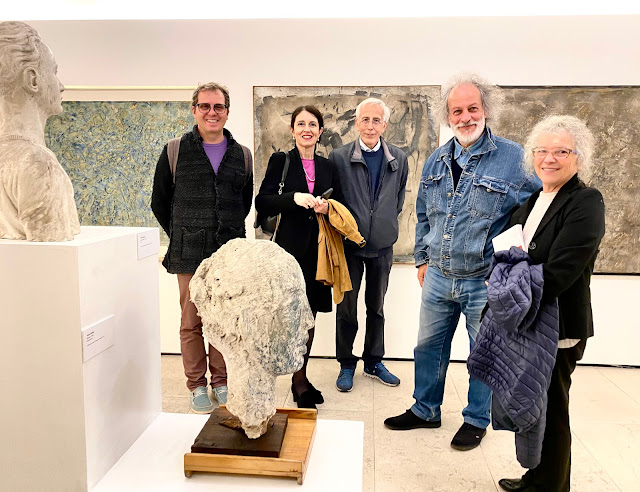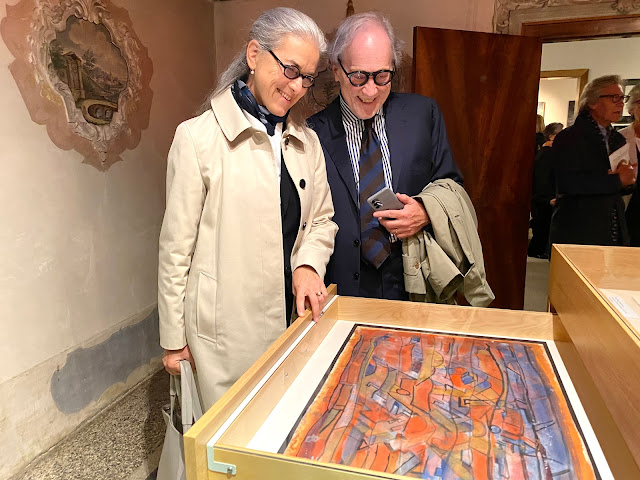Feltre - Museo d'Arte Moderna - Carlo Rizzarda
Valerio Bellati - Alchimie Cromatiche
In Feltre at the Museo d'Arte Moderna - Carlo Rizzarda - the exhibition - Valerio Bellati: Alchimie Cromatiche - until January 14 - curated by Francesco Michielin. This exhibition is particularly significate as it celebrates the hundredth anniversary of the artist's birth whose family has Feltre origins. Valerio Bellati's refined and lyrical paintings are characterized by precious mixtures, modulated on subtle contrasts of tones and colours, abstract paintings of a very personal expression and as such profoundly biographical. The exhibition features around fifty works including drawings, paintings and sculptures, offering the visitor the opportunity to get to know a highly original interpreter of the lively Venetian artistic climate of the second half of the twentieth century.
Self- Portrait - 1948
Valerio Bellati
you have to wait for the painting to meet you".
Erza Pound
Bellati’s art is characterised by large canvases, blue, grey and rust paintings, mixtures of colour on rough paper, use of sacks, black “markings” with “dustings” of ash. While commenting one of his paintings, Ezra Pound stated: «When standing in front of a work of Valerio Bellati, you have to wait for the painting to meet you».
Untitled - 1988 - Untitled - 1988 - Untitled - 1990
The opaque blue of the skies painted in the Cappella degli Scrovegni, in Padova, the town of his birth, were the model for his search of blue, as the light of Venice, a precious, Byzantine light, also had great influence on his work.
"...His autobiographical paintings, soaked in cultured references,
will be able to fascinate contemporary art experts, but will
also captivate those who are simply in search of
visual inspiration, with their elegance and refined
chromatic alchemy".
Mayor of Feltre - Viviana Fusaro and Flavia Colle - Councilor for Culture
"...the City Administration desires to offer an exhibition dedicated to Valerio Bellati. He has been a solitary yet original artist, whose family was originally from Feltre, and who was strongly inspired by Tancredi during the 1950s and hung out with Riccardo Licata and Gianni Palminteri, as well as with Hiao Chin, the pioneer of Chinese abstractionism... His autobiographical paintings, soaked in cultured references, will be able to fascinate contemporary art experts, but will also captivate those who are simply in search of visual inspiration, with their elegance and refined chromatic alchemy. In addition to this, there is the bond with Andrea Zanzotto, one of the greatest poets of the second half of the 20th Century, with whom, shortly before his passing, Bellati brought to life Versi e dipinti.
Art Conservator, Tiziana Casagrande and the Councilor for Culture, Flavia Colle
Luciana Cortina, Annalisa e Libero Zugni, Milla Villabruna and Giuseppe Tirone
"The painter does not like bright colours, but rather discreet assonances, the wonder of sudden flashes, of optical jumps brought by intense elaborations ... His marks and colours are discreet yet vibrant at first glance, revealing then a particular vibrancy; they are paintings where colour is intrinsically bonded to the mark".
Letizia Tedeschi
1992
Untitled 1992 - Untitled - 1994
Bellati sometimes relied on “found” colours, as in La lamiera del Piave. In each case a great richness of colours can be observed, from natural pigment to the liquid colour of Pollock’s “dripping”, to acrylics squeezed directly onto the canvas. Some of these works denote a powerful incidence of gesture. He also created works defined as “primitive”, in which he would intervene on plastically modelled canvas with a “dusting of ash”. In fact, paintings of opaque material coexist with extremely bright ones.
Untitled - 1994
Francesco and Mariolina Michielin
Despite his illness, before his death in 1996, Bellati was able to complete his latest work Versi e Dipinti together with the poet Andrea Zanzotto, one of the greatest Italian poets of the second half of the 20th Century.
Valerio Bellati and Andrea Zanzotto - Versi e Dipinti - Tipoteca Italiana - 1996
“...mixtures found almost accidentally, yet after hours of research,
as if he was an alchemist”.
Hsiao Chin
The last period of his life, was characterised by intense experimentalism, which led Bellati to rediscover his love for the sack, used in a very different way from Burri - to use burnished papers - and to try to replicate the fresco effect. The frequent occasional nature of the medium, such as coarse, wrinkled paper, is matched by an always strongly pondered choice of colours, resulting, as Hsiao Chin pointed out in 1992, from “mixtures found almost accidentally, yet after hours of research, as if he was an alchemist”.
Untitled - 1991
Valerio Bellati’s artistic career started with sculpture, gradually approaching painting as the privileged medium of his poetics, which used abstract expressionism as its main expressive style.
Figuretta - 1961
Massimiliano and Nicoletta Bellati
Piazza Maggiore


























